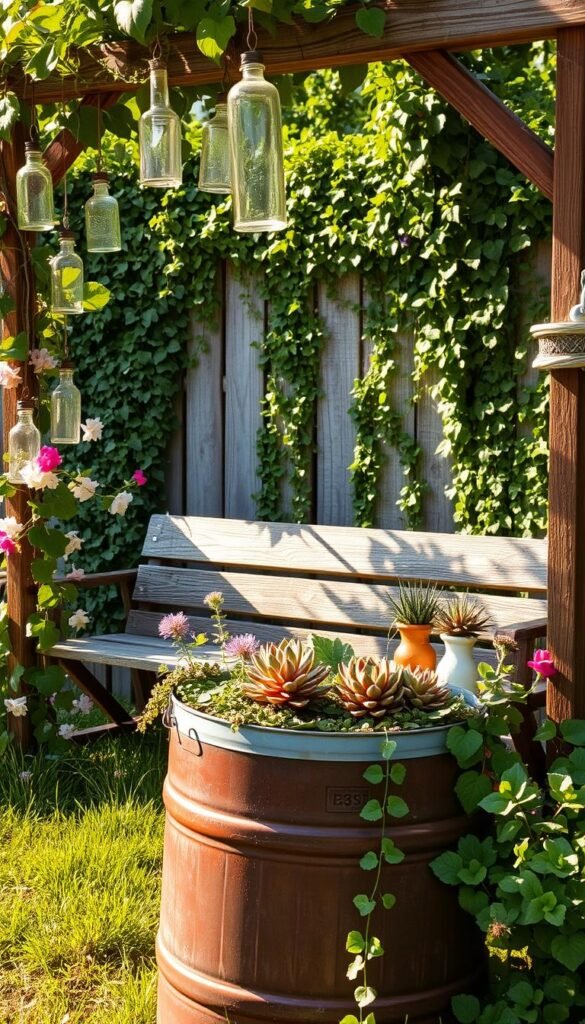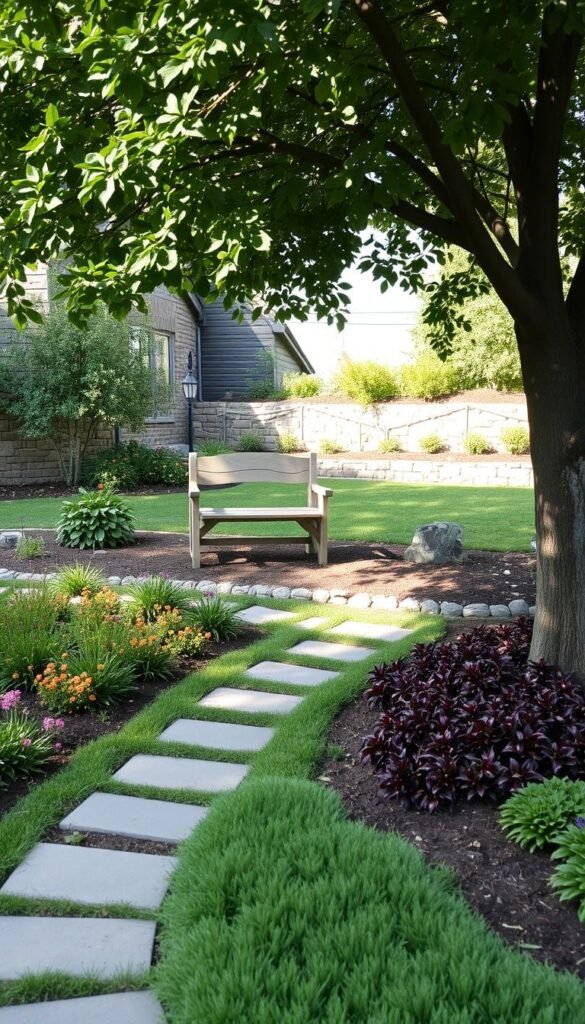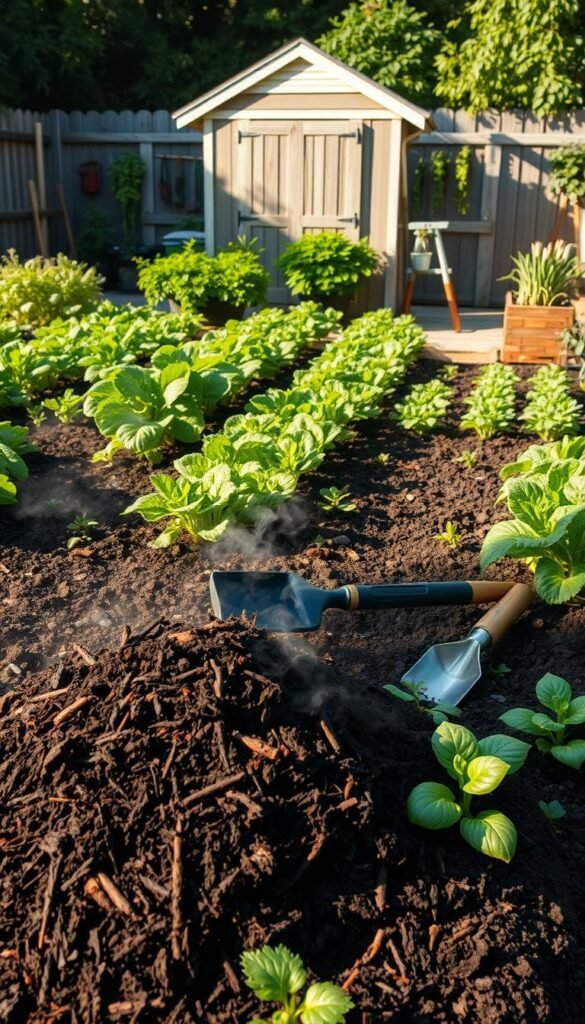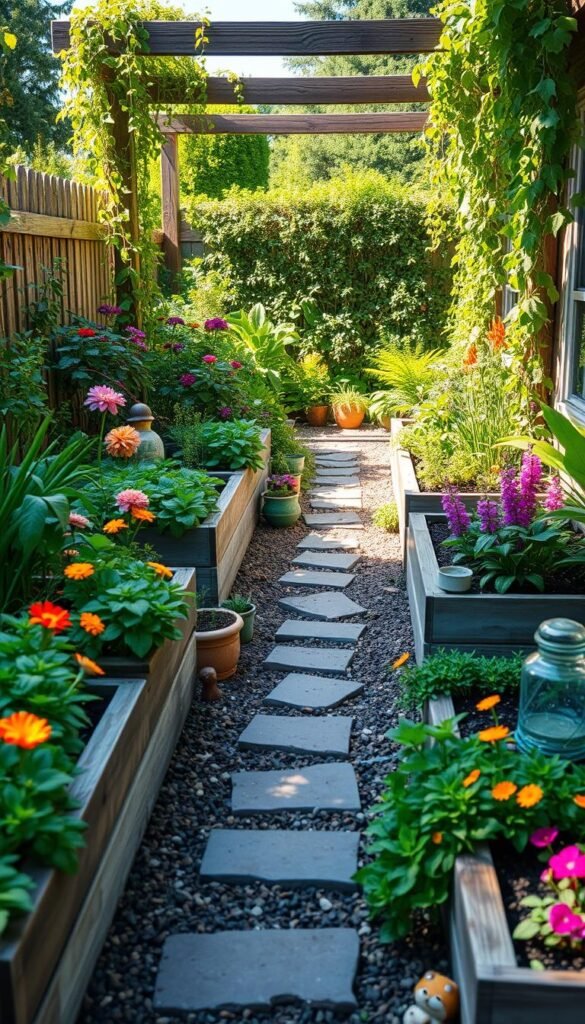Creating a beautiful outdoor retreat doesn’t require deep pockets. With smart budget tricks and a dash of creativity, you can turn even a small garden into a lush escape. Vertical planters, thrifted pots, and upcycled materials prove stunning results come from simple ideas.
Start by assessing your space and sunlight—this helps pick the right plants that thrive year-round. From tiered herb baskets to repurposed furniture, small changes deliver big impact. Gabriela Herman’s porch swing, for example, shows how affordable touches add charm.
Start Small: Budget-Friendly Planning for Your Backyard Garden
Transforming your outdoor area starts with smart planning, not big spending. By focusing on your space and sunlight, you can create a thriving garden without breaking the bank. Here’s how to begin.
Assess Your Space and Sunlight
Track sunlight patterns using free apps like Sun Surveyor. Note shady corners and sunny spots—microclimates matter. For example, damp areas suit ferns, while dry zones thrive with succulents.
Measure your space with the stride method (1 pace ≈ 3 feet). This helps plan layouts for plants or DIY projects like vertical gardens.
Repurpose Household Items as Planters
Turn home clutter into charming planters:
- Colanders: Drill holes for hanging herb gardens.
- Dresser drawers: Paint with exterior-grade paint for raised beds.
- Gutters: Mount along fences for strawberry channels.
Photographer Gabriela Herman painted salvaged trellises to blend with greenery—proof that small touches elevate a garden.
DIY Projects to Transform Your Outdoor Space
Revamping your outdoor area with DIY projects adds personality without draining your wallet. From salvaged wood to corrugated plastic, these ideas turn unused space into functional art. Best of all, most cost under $10.
Build a Rustic Potting Station from Salvaged Wood
Old pallets or fence boards make perfect potting stations. Here’s how:
- Join wood with exterior screws for durability.
- Seal with linseed oil (cheaper) or polyurethane (longer-lasting).
- Add hooks for tools and a shelf for seed trays.
Kritsada Panichgul’s vertical gardens prove even scrap wood shines with a little effort.
Create Geometric Planters from Corrugated Plastic
For a modern twist, craft angular planters:
- Cut plastic sheets with a box cutter—try hexagons or triangles.
- Secure edges with waterproof glue.
- Paint with outdoor acrylics for pops of color.
Carson Downing’s $5 designs show how chic meets cheap.
Hang Vertical Gardens on Blank Walls
Turn dull walls into lush features:
- Use a French cleat system for easy mounting/removal.
- Insert nursery flats as modular plant pockets.
- Run drip irrigation lines for low-maintenance watering.
No expensive kits needed—just creativity and basic tools.
Affordable Plant Choices for Year-Round Beauty
Smart plant choices keep your space vibrant without draining your wallet. Focus on varieties that multiply, thrive from seeds, or pull double duty as decor and dinner.
Grow Perennials That Multiply Over Time
Clump-forming perennials like geums and astrantia save money by dividing every few years. Split them in spring or fall to fill new beds for free.
Top self-seeding picks:
- Coneflowers: Drought-tolerant and pollinator-friendly.
- Black-eyed Susans: Spreads cheerfully in sunny spots.
- Lupines: Adds vertical interest with minimal care.
Start Vegetables from Seed Packets
Seed packets cost 80% less than nursery plants. Use egg cartons and plastic wrap for dollar-store sprouting. Pro tip: Label with wine corks (upcycled from Section 5!).
Pair vegetables strategically using a raised beds layout. Basil boosts tomato flavor, while marigolds deter squash pests.
Mix Herbs with Flowers for Function and Flair
Edible flowers like nasturtiums and calendula add color to salads. Plant them alongside thyme or rosemary for a fragrant, useful border.
“Preserve extra herbs in ice cube trays with olive oil—winter flavor ready in seconds.”
Regional native plants (check local extension lists) need less water and upkeep, stretching your budget further.
Creative Upcycling: Garden Decor on a Dime

Breathing new life into forgotten items can transform your outdoor space without costing a fortune. From worn-out boots to wine corks, everyday objects become eye-catching accents. These projects prove style thrives on creativity, not cash.
Turn Old Boots into Quirky Planters
Leather or rubber boots make charming planters for small flowers or succulents. Pelargonium Europe’s wellie designs show how gravel layers prevent soggy roots. Follow these tips:
- Drill 1/4″ drainage holes in soles using a rotary tool.
- Seal cracked leather with Flex Seal spray to extend their life.
- Pair mismatched boots along pathways for playful height variation.
Use Wine Corks as Plant Markers
Jack Sutcliffe’s bamboo-skewer markers solve the “what did I plant?” dilemma. Preserve corks with clear acrylic spray for weather resistance. Get creative:
- Assign red wine corks to tomato plants, white to herbs like basil.
- Write labels with permanent marker or wood-burning tools.
- Press corks into soil near seedlings for instant organization.
DIY flair doesn’t stop there. Broken ceramics become mosaic borders, while bicycle baskets hold trailing petunias. Even vinyl records spin into whimsical wind catchers. Your garden’s personality grows with every upcycled detail.
Smart Space-Saving Solutions
Maximize every inch of your outdoor area with clever space-saving tricks. Whether you’re working with a balcony or a tiny yard, vertical and modular designs unlock hidden potential. These strategies let you grow more plants without sacrificing style.
Install Tiered Hanging Baskets
Stacked baskets multiply planting real estate. Use macramé hangers for heavy vegetables like cherry tomatoes. Try these tips:
- Mix trailing and upright plants: Pair petunias with compact herbs.
- Recycle IV tubing: Create self-watering systems for baskets.
- Rotate weekly: Ensure all sides get equal sun exposure.
Train Vines on DIY Trellises
Fast-growing vines like morning glories or hops transform fences into living walls. Build trellises from salvaged wood or tension wires:
- Espalier fruit trees: Train apples or pears as living fences (Bob Stefko’s method).
- Use wider-spaced slats: Saves material while supporting climbers (Peter Krumhardt’s hack).
- Add modular cinder blocks: Stack them to build adjustable vertical garden beds.
For heavy-fruiting plants, reinforce structures with galvanized wire. A rotating stand lets you chase the sun—perfect for patio tomatoes or bush cucumbers. Small space? Think upward!
Budget-Friendly Hardscaping Ideas

Hardscaping doesn’t have to drain your savings—smart choices create stunning paths and borders. Crushed rock costs 60% less than flagstone, proving design thrives on creativity, not cash. Whether you’re upgrading a patio or defining garden beds, these ideas maximize impact on a dime.
Arrange Pavers with Gravel Fillers
Pair inexpensive pavers with gravel for a polished look. Use online calculators to estimate quantities—polymeric sand stabilizes pea gravel, preventing weeds. DIY tip: Source free stones from local landscapers for filler material.
For drainage-friendly patios, try permeable paving. Broken concrete chunks form mosaic patterns, while recycled bricks set at 45° angles add rustic edging. Solar-powered cap lights boost nighttime visibility.
Build Dry-Stack Stone Borders
Matthew Benson’s dry-stack method uses nursery leftovers for natural borders. Skip mortar—stack flat stones tightly, ensuring stability. This technique works for:
- Garden beds: Define edges without costly materials.
- Yard pathways: Frame walkways with textured contrast.
- Sloped spaces: Prevent erosion with tiered designs.
“Dry-stacking is forgiving—adjust stones as needed for a custom fit.”
For extra flair, tuck drought-tolerant sedums between gaps. These low-effort touches elevate your garden’s structure year-round.
Thrifty Water Features and Lighting
Add charm to your outdoor space with budget-friendly water and lighting tricks. A bubbling pond or twinkling lights can transform your patio or yard into a cozy retreat—no hefty price tag needed.
Create a Container Pond from a Stock Tank
Buff Strickland’s stock tank ponds prove elegance costs under $100. These sleek designs fit small yards and attract birds. Start with a galvanized tank (available at farm stores) and follow these tips:
- Filter naturally: Add aquatic plants like water lilies to keep water clear.
- Prevent algae: Drop barley straw bundles—they release enzymes that block growth.
- Hide pumps: Bury cords under mulch or use decorative rocks for a seamless look.
String Solar-Powered Fairy Lights
Brie Williams’ solar lights last 8–10 hours and cost pennies to run. Drape them over fences or trees to brighten your garden’s ambiance. Pro tips:
- Zone lighting: Use brighter lights for task areas (grilling spots) and softer ones for pathways.
- Waterproof connections: Seal joints with marine-grade adhesive to withstand rain.
- Repurpose jars: Fill mason jars with LED tea lights for rustic lanterns.
“Dusk-to-dawn sensors save energy—lights auto-adjust to sunset times.”
Seasonal Swaps That Save Money

Refresh your outdoor space with simple seasonal changes that keep costs low. By rotating textiles and plants strategically, you’ll maintain year-round appeal without replacing furniture or breaking the bank.
Rotate Cushion Covers Instead of Furniture
Debenhams’ waterproof covers ($12+) let you update your patio palette instantly. Choose fade-resistant fabrics like solution-dyed acrylic—they withstand summer sun without losing vibrancy.
Smart storage keeps off-season textiles fresh:
- Vacuum-seal bags prevent mildew in damp climates
- Labeled bins by season simplify rotations
- Hanging racks in sheds avoid creases
Grow Quick-Blooming Annuals for Summer Color
Dobbies’ petunia varieties deliver instant flowers from May through frost. Pair with succession planting for continuous blooms:
“Sow zinnias every 2 weeks—they’ll replace fading pansies seamlessly.”
Extend your garden’s life with these thrifty tricks:
- Overwinter geraniums in paper bags (store in cool, dark places)
- Build cold frames from old windows to protect fall seedlings
- Swap container plants seasonally—tulip bulbs make way for marigolds
For holidays, apply removable decals to terracotta pots. A pumpkin stencil in October or snowflake motif in December adds festive flair for pennies.
Low-Cost Seating and Entertainment Areas
Your outdoor space can become a cozy gathering spot without expensive furniture. With simple materials and clever DIY tricks, you’ll create inviting seating and fun zones for less than $100. Let’s explore two standout projects that transform basic supplies into stylish retreats.
Build Sturdy Concrete Block Benches
Matt Clark’s cinder block designs prove comfort meets affordability. For under $50, you can assemble weather-resistant seating perfect for your patio or yard. Follow these pro tips:
- Distribute weight evenly: Place blocks horizontally with openings facing outward for stability.
- Add marine-grade foam pads: These withstand rain and sun better than regular cushions.
- Customize with paint: Use outdoor spray paint to match your garden’s color scheme.
For tabletops, repurpose salvaged wood or thrifted doors. Secure them with construction adhesive for wobble-free surfaces. These benches handle everything from morning coffee to game nights.
Convert a Shed Into a Cozy Hideaway
Blaine Moats’ peel-and-stick wallpaper trick turns storage sheds into charming retreats. Start by insulating windows with bubble wrap kits ($8 per roll) to regulate temperature. Then:
| Upgrade | Cost | Impact |
|---|---|---|
| Wallpaper accent wall | $15+ | Instantly brightens small spaces |
| String lights | $12 | Adds evening ambiance |
| Folding bistro set | $35 | Creates dining/craft area |
“Layer rugs over plywood floors—outdoor versions handle moisture while adding warmth.”
For entertainment zones, hang king-size sheets between trees for movie screens. Waterproof Bluetooth speakers ($25+) deliver crisp sound without wiring. Build cornhole boards from scrap wood—they double as storage when not in use.
Market umbrellas ($40 at discount stores) provide movable shade. Anchor them in weighted planters for stability during breezes. Your transformed area will become the neighborhood’s favorite hangout spot.
Paint Tricks That Elevate Your Garden

A fresh coat of paint can redefine your outdoor space without costly renovations. From camouflaging boundaries to reviving old furniture, these techniques blend creativity with practicality. Best of all, most projects cost under $20.
Use Black Paint to Make Fences “Disappear”
Andrew Duff’s Cuprinol Ducksback trick creates depth. Dark hues recede visually, making small yards feel larger. For best results:
- Prep surfaces: Sand rough spots or use chemical strippers for peeling layers.
- Choose matte finishes: Gloss reflects light, reducing the illusion effect.
- Pair with greenery: Plants pop against dark backdrops for a lush look.
Refresh Old Furniture with Outdoor Spray Paint
Rust-Oleum’s 2X Ultra Cover revitalizes metal or plastic in minutes. Key steps:
- Clean with vinegar to remove rust or mildew.
- Apply thin coats—thick layers chip faster.
- Seal with clear acrylic for UV protection.
| Paint Type | Best For | Cost |
|---|---|---|
| Behr Marquee | Fade-resistant fences | $35/gallon |
| Sherwin-Williams Resilience | High-moisture areas | $40/gallon |
For playful touches, stencil geometric patterns on concrete slabs. Chalk paint mimics vintage charm—seal it with polycrylic to withstand rain. Dark colors like navy or charcoal make bright flowers stand out, while pastels soften modern designs.
“Test samples on scrap wood first—natural light changes paint undertones.”
Wildlife-Friendly Additions That Don’t Break the Bank
Inviting wildlife into your space adds charm while keeping costs low. Simple tweaks like homemade feeders and native plants create a buzzing ecosystem. Best of all, these projects often use materials you already own.
DIY Tin Can Bird Feeders
Jack Sutcliffe’s $0 method turns cans into cheerful feeders. Clean and paint cans, then fill with safe seed mixes. Avoid invasive seeds like Johnson grass—stick to sunflower or millet.
- Hang with wire: Suspend from tree branches or shepherd’s hooks.
- Squirrel-proof: Add baffles or use cayenne pepper to deter pests.
- Group multiples: Cluster feeders to attract diverse species.
Native Plants for Pollinators
Marshalls’ research shows native flowers reduce water use by 30%. Choose region-specific varieties like coneflowers or milkweed. These support bees, butterflies, and birds year-round.
“A single milkweed plant hosts 450+ monarch caterpillars—proof that small choices have big impact.”
Boost biodiversity with these extras:
- Bee hotels: Drill holes in untreated logs for solitary bees.
- Puddling stations: Mix sand and water in shallow dishes for butterflies.
- Night gardens: Plant moonflowers or evening primrose for moths.
Even overturned pots create amphibian hideouts. Layer rocks and moss for a cool, damp retreat. Your garden will thrive with life—and your wallet stays full.
Soil and Compost Hacks for Healthy Plants

Healthy soil is the secret to thriving plants, and it doesn’t have to cost a fortune. With a few smart tricks, you can enrich your garden’s foundation while sticking to your budget. From kitchen scraps to coffee grounds, nature provides free amendments that boost growth.
Turn Kitchen Scraps into Black Gold
Compost bins slash fertilizer costs by 100%, according to Power Sheds. Start with a simple pile or try space-saving methods:
- Bokashi bins: Ferment scraps in airtight containers for small balconies.
- Red wiggler worms: Vermicomposting processes waste faster than traditional piles.
- Grasscycling: Leave lawn clippings to decompose naturally—they return nitrogen to the soil.
“Balance green (fruit peels) and brown (dry leaves) materials at a 1:3 ratio for odor-free composting.”
Repurpose Household Waste as Fertilizer
Everyday items can nourish your plants:
- Coffee grounds: Lower pH for acid-loving blueberries and azaleas.
- Fireplace ash: Sprinkle lightly for potassium—ideal for flowering vegetables like tomatoes.
- Leaf mold: Pack fallen leaves in mesh bins for nutrient-rich mulch.
Test soil pH with pantry staples: vinegar bubbles in alkaline dirt, while baking soda reacts in acidic beds. Your herbs and flowers will flourish with these free fixes.
Budget-Conscious Lawn Alternatives
Swap thirsty turf for eco-friendly options that save water and money. Traditional grass demands constant care, but clover lawns and creative pathways cut maintenance by half. Whether you’re redesigning a small patio border or revamping your entire yard, these solutions balance beauty and practicality.
Seed Clover for Drought-Resistant Ground Cover
Microclover needs 60% less water than Kentucky bluegrass, according to Dmitriy Popoff’s research. Its deep roots prevent soil erosion while staying green during dry spells. Compare popular varieties:
| Type | Height | Best For |
|---|---|---|
| Microclover | 2-4 inches | High-traffic areas |
| Dutch white | 6-8 inches | Meadow-like designs |
For shady spots, consider moss gardens. They thrive without mowing or fertilizing. Buffalo grass is another tough alternative—it survives on rainfall alone in most climates.
Define Shapes with Edged Pathways
Edward Gohlich’s studies show gravel paths cost 75% less than poured concrete. Use recycled bricks as edging for a polished look. Space stepping stones 24 inches apart—the average adult stride length.
Top permeable options:
- Decomposed granite: Packs firmly for wheelbarrow access
- Wood chips: Free from local arborists (call for chip drops)
- Crushed shells: Ideal for coastal garden themes
Solar pathway lights ($5/unit) add nighttime visibility. For curves, lay garden hoses as temporary guides before digging. Your space will feel intentional without the high price tag.
Multi-Functional Furniture and Storage
Smart storage solutions can transform cluttered patios into organized retreats. By choosing pieces that serve multiple purposes, you’ll maximize your outdoor space without crowding the area. From hidden compartments to upcycled organizers, these ideas blend practicality with personality.
Benches That Work Overtime
Matthew Benson’s concrete block designs prove seating can be stylish and functional. Waterproof storage ottomans ($25 at discount stores) keep cushions dry while hiding gardening gloves or twine. For larger spaces, try these upgrades:
- Lift-top coffee tables: Build from pallets with piano hinges for tool storage
- Crib conversions: Remove one side to create vertical plant stands
- Cooler side tables: Use vintage models with built-in ice storage for drinks
“Measure twice before building—standard bench height (18″) ensures comfort during long gatherings.”
Repurpose Everyday Items as Organizers
Westbury’s shed makeover shows how shoe racks become perfect tool stations. Mount them horizontally to hold potting soil bags vertically. Other clever swaps:
- Magnetic knife strips: Hang tools within easy reach
- Over-door organizers: Store seed packets in clear pockets
- Bicycle baskets: Mount on walls for trailing plant displays
For small patio corners, stack vintage suitcases as weatherproof storage. Line them with plastic sheeting to protect garden supplies from rain. Your outdoor space will stay tidy while showcasing your DIY flair.
Theme Ideas for Cohesive Garden Design
A well-planned theme ties your outdoor space together effortlessly. Whether you love cottage charm or modern minimalism, strategic styling creates harmony. Focus on color schemes, focal points, and repeating elements for a polished look.
Cottage-Style with Mismatched Containers
Laurie Black’s whimsical garden proves magic lives in the mix. Combine vintage teapots, painted buckets, and terracotta pots for relaxed charm. Soften with pastel flowers like cosmos or foxgloves.
Key tips for cottage design:
- Layer textures: Pair rough burlap with delicate china saucers.
- Repurpose creatively: Turn colanders into hanging baskets or drawers into raised beds.
- Add vertical interest: Train sweet peas on salvaged ladders or trellises.
Modern Minimalist with Monochromatic Pots
BH&G’s sleek designs showcase how simplicity speaks volumes. Stick to one color—charcoal, white, or slate—for a unified effect. Geometric concrete planters amplify your patio’s modern edge.
For a curated look:
- Limit plant varieties: Stick to 3–5 types (e.g., snake plants, ornamental grasses).
- Align shapes: Square pots complement angular furniture.
- Incorporate negative space: Let empty spots highlight key plants.
“Monochromatic doesn’t mean boring—vary pot heights and diameters for dynamic rhythm.”
Transition between themes by zoning your garden. A cottage-style seating nook can flow into a minimalist succulent display near the innovative garden design pathways. Your space will feel intentional, not chaotic.
Your Lush Backyard Oasis Awaits
Your dream outdoor space is closer than you think—no hefty investments needed. With clever budget-friendly tweaks like repurposed planters and native plants, you’ll create a vibrant retreat that grows richer over time.
Start small: refresh a patio corner with thrifted pots or build a compost bin for long-term savings. Perennials like coneflowers pay off yearly, while DIY projects add personality without the price tag.
Remember, your garden evolves. Rotate seasonal blooms, maintain tools, and let each change reflect your style. Ready to begin? Pick one high-impact project this weekend—your lush oasis starts with a single step.






